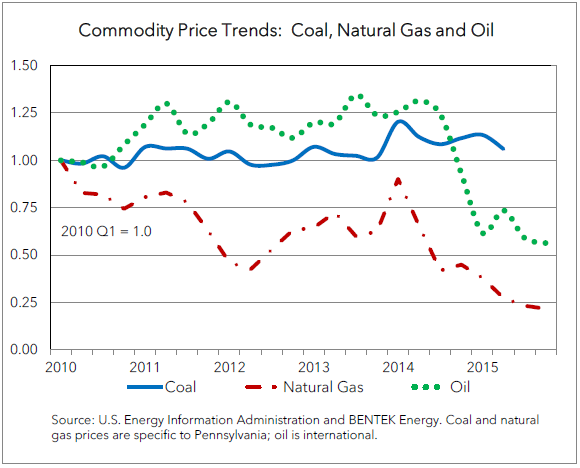December 2015
January 01, 2016 | Revenue & Economic Update

The latest data from the U.S. Bureau of Labor Statistics reveal a significant employment contraction for the Pennsylvania coal mining sector (NAIC 2121). 1 From Fall 2011 to Fall 2015, employment in that sector contracted by roughly 2,200 payroll jobs (25.3%). National data reveal a similar contraction for the U.S., as employment declined by approximately 23,500 (26.3%) payroll jobs during that time period.
One factor driving these employment trends is the abundant supply of natural gas and the decline in natural gas prices. Coal and natural gas are both used to generate electricity. Historically, coal has been relatively cheaper and comprised a larger share of the energy inputs used to generate electricity by Pennsylvania utilities. However, data from the U.S. Energy Information Administration reveal a recent dramatic reversal.2 In 2010, coal comprised 48.0% of inputs used by generators of electricity in Pennsylvania, while natural gas comprised 14.7%. By 2015, the respective shares were 31.5% and 27.3% (data through October).
The graph below illustrates the significant decline in oil and natural gas prices relative to coal. From the first quarter of 2010 through the second quarter of 2015, Pennsylvania coal prices increased by 6.0%. By contrast, local natural gas prices (Dominion South hub) declined by 78.3% through the final quarter of 2015, while the price of a barrel of oil fell by 43.7%. Analysts expect that these trends will continue into 2016. Hence, the employment contraction in the Pennsylvania coal mining sector could extend into the new year.
In addition to the decline in natural gas prices, other developments have also challenged the coal industry. More stringent environmental regulations have increased operational costs for coal-burning electricity generators.3 Demand from major importers of coal has also softened due to various technical factors. For 2014, data from the U.S. Census Bureau show that the value of Pennsylvania coal exports dropped by roughly one-quarter from the prior year. For 2015, preliminary data suggest a further reduction of more than fifty percent from 2014 levels.